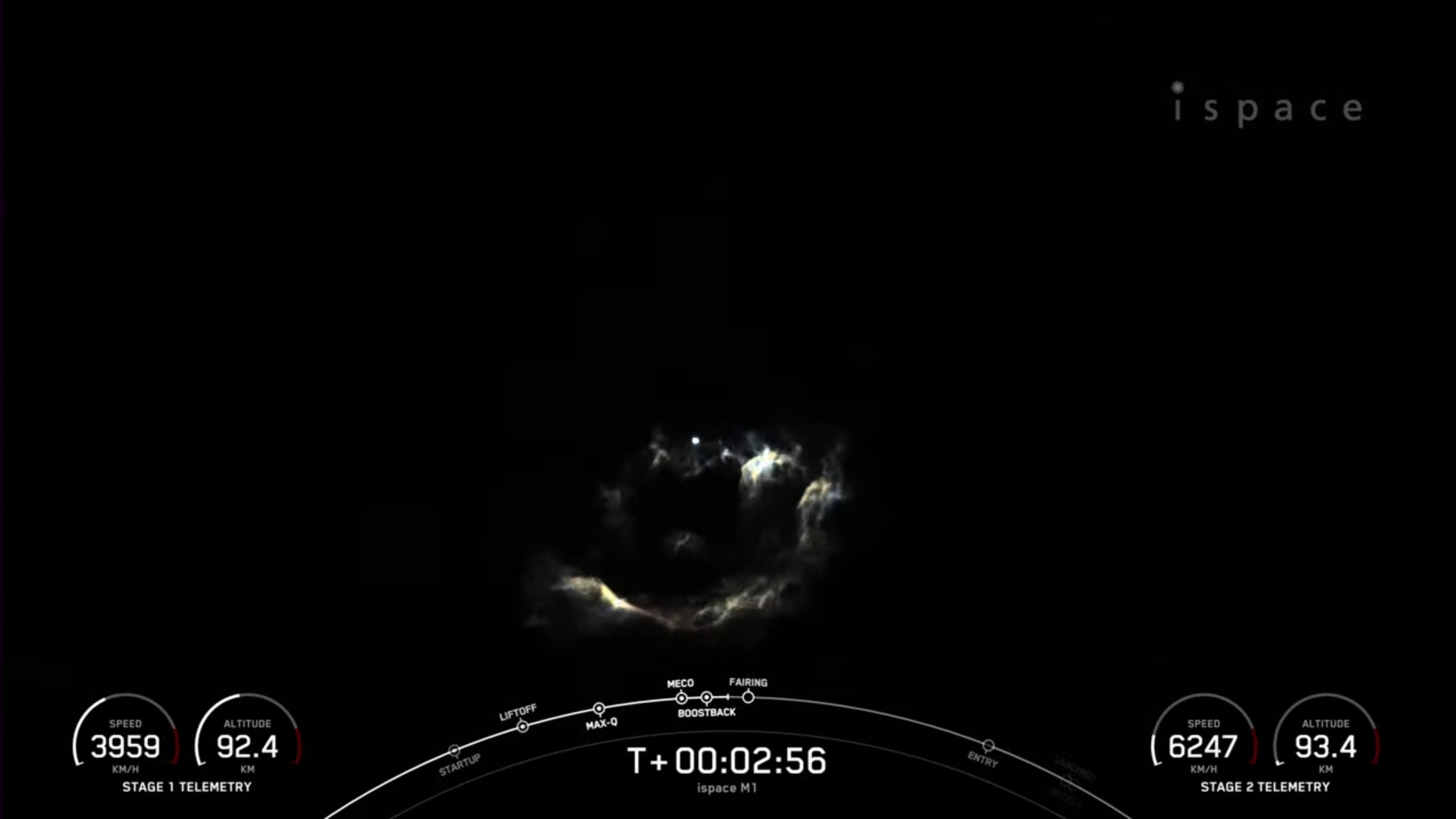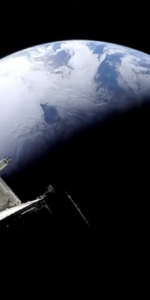
The fourth and fifth sovereign nations to land a homegrown craft on another world held their breath early Sunday, as a five-times-used SpaceX Falcon 9 booster roared aloft from storied Space Launch Complex (SLC)-40 at Cape Canaveral Space Force Station, Fla. The veteran B1073 core—first launched last May—rose into the pre-dawn darkness at 2:38 a.m. EST, laden with Japan’s Hakuto-R lunar lander, the United Arab Emirates’ (UAE) Rashid rover and NASA’s water-ice-seeking Lunar Flashlight. Tonight’s launch marked the 56th SpaceX launch of 2022


Current plans envisage Hakuto-R and Rashid touching down on the Moon late next April, with Lunar Flashlight targeting a polar orbit which will bring it as close as 12 miles (20 kilometers) from the surface of the lunar South Pole. Success will make Japan and the UAE the newest members of an exclusive club of nations which has so far seen only Russia, the United States and China land a spacecraft on our closest celestial neighbor.
The Falcon 9 booster which executed Sunday’s spectacular launch was B1073, which entered the SpaceX fleet last May and lifted 53 Starlink internet communications satellites—with a mass that totaled over 35,800 pounds (16,250 kilograms)—into low-Earth orbit. In doing so, she became the first Falcon 9 core to fly a Starlink payload on her very first voyage; all previous Starlinks had ridden flight-proven boosters.

Six weeks later, at the end of June, she returned briskly to business to deliver the heavyweight SES-22 geostationary communications satellite for Luxembourg-headquartered SES. More recently, in the second week of August and again in late September, B1073 roared to space with two further Starlink batches; all told, on the eve of Sunday’s launch, she has now lifted 157 of these flat-packed internet communications satellites to orbit.
Her first four missions ended with pinpoint touchdowns on the deck of the Autonomous Spaceport Drone Ship (ASDS), situated offshore in the Atlantic Ocean, but for the Hakuto-R mission B1073 would—for the first time in her career—attempt a “land” touchdown on Landing Zone (LZ)-2 at Cape Canaveral. In doing so, she would closely follow her seasoned sister B1069, which last Thursday achieved a land landing at neighboring LZ-1 for the first time, after a trio of prior ASDS landings.

As previously noted by AmericaSpace, Hakuto-R is the first in a series of lunar missions developed and financed by Tokyo, Japan-based ispace, Inc., which in September 2018 selected SpaceX as its launch services provider. However, the launch slipped from an original placeholder in 2021 into the fall of 2022 and when the spacecraft arrived in Florida over the Halloween period, a target date range extending from 9-15 November had been abandoned in favor of a No Earlier Than (NET) target of 22 November.
The revised timeline, ispace noted, “allows for best preparation for the mission when considering the fuel-loading schedule for the lander and launch date availability”. But by mid-November, that date had slipped to NET 28 November, then again to the 30th, in response to unfavorable weather at the Cape, and finally to NET 1 December, after which SpaceX formally stood the mission down for more than a week to conduct unspecified checks and data reviews on the Falcon 9 launch vehicle.

After several days of official silence, last week SpaceX tweeted that its teams had “completed additional vehicle inspections and reviews” and that both “rocket and payload are looking good” for a new launch attempt at 2:38 a.m. EST on Sunday, 11 December. This near-two-week delay was prompted in part by a lunar trajectory blackout period—spanning 3-6 December—during which time it was considered more difficult for the mission to navigate to its intended orbit.
In the meantime, ispace explained that it planned “no major operational changes” to the mission, so long as the launch was completed before the middle of December. This would still provide the proper trajectory and flight conditions for a lunar landing by the end of April 2023 and preserve Hakuto-R’s primary touchdown spot on the Moon.
That primary location, the crater Atlas, sits to the southeast of Mare Frigoris (the “Sea of Cold”) in the Moon’s northeastern quadrant. The crater itself measures 54 miles (87 kilometers) in diameter and its terraced walls rise up to 1.2 miles (2 kilometers) above the crater’s floor. Its interior is rough and hilly in nature, exhibiting floor fractures which might be a telltale indicator of past volcanic activity.
“Careful consideration of the target site criteria included continuous Sun-illumination duration and communication visibility from the Earth,” ispace noted. “Alternate landing targets include Lacus Somniorum, Sinus Iridium and Oceanus Procellarum, among others. Landing is currently expected to take place around the end of April 2023.”
The Hakuto-R lander is a revision (or “reboot”, hence the “R”) of a mission which originally saw life after 2007 as a candidate for the Google Lunar X-Prize. This inducement prize contest, organized by the X-Prize Foundation and sponsored by Google, challenged competitors to land a spacecraft on the Moon, traverse 1,600 feet (500 meters) across its surface and transmit high-definition imagery and data back to Earth.

As circumstances transpired, none of the original 32 teams—which dwindled to just five, including Japan’s Hakuto (“White Rabbit”) team, by January 2017—ever got to the point of reaching the Moon by the $20 million first-prize deadline of 2012 or the $15 million reduced deadline of 2014. By early 2018, with the deadline having been extended several more times, the X-Prize Foundation announced that the prize would go unclaimed.
In the summer of 2019, however, Japan’s mission received a new lease of life as Hakuto-R, having already secured SpaceX as its launch provider. And in April 2021, the UAE’s Mohammed bin Rashid Space Centre (MBRSC) inked contracts with ispace to deliver its Rashid rover aboard Hakuto-R.
Rashid, named for Dubai’s late ruler, Sheikh Rashid bin Saeed Al Maktoum (1912-1990), is a four-wheeled rover, equipped with two high-resolution cameras, a microscopic camera for fine and detailed imaging and a thermal imaging camera, plus a Langmuir probe to examine the Moon’s plasma environment and the characteristics of the abrasive lunar dust. Rashid weighs about 22 pounds (10 kilograms) and is the size of a microwave oven.
Hakuto-R also includes multiple rideshare payloads, devoted to lunar surface science. The Japan Aerospace Exploration Agency (JAXA) has provided a small-scale, two-wheeled “transformable” rover, measuring 3 inches (80 millimeters) in diameter, and an Artificial Intelligence (AI) flight computer aboard Hakuto-R will facilitate communications algorithms with Rashid. Other payloads include a solid-state battery test module, multiple cameras and panels engraved with the names of Hakuto-R’s crowdfunding sponsors.

Also hitching a ride aboard this morning’s Falcon 9 flight is NASA’s Lunar Flashlight, a 6U-class CubeSat designed to locate and estimate the size and composition of water-ice deposits from polar orbit around the Moon. The tiny CubeSat, provided by the Jet Propulsion Laboratory (JPL) of Pasadena, Calif., was initially slated to ride Artemis I, but ultimately missed its integration “window”.
It weighs about 30 pounds (14 kilograms) and carries near-infrared lasers and an on-board spectrometer. Lunar Flashlight will map water-ice concentrations at scales of 0.6-1.2 miles (1-2 kilometers) from an orbit which should carry it as close as 12 miles (20 kilometers) from the Moon’s South Pole.

Liftoff occurred on time at 2:38 a.m. EST Sunday, as B1073 powered her way smoothly uphill under the thrust of her nine Merlin 1D+ engines. The core separated from the stack at 2.5 minutes into ascent and pirouetted to a picture-perfect landing on LZ-2, marking the second “land” landing of a Falcon 9 in under half a week, an achievement seen only once before, earlier in 2022—albeit following launches from the East and West Coasts. Never before have a pair of “single-stick” Falcon 9 boosters landed on the East Coast within a week of each other.
The baton was now picked up by the single Merlin 1D+ Vacuum engine of the rocket’s second stage, which burned for almost six minutes to deliver the payload stack to orbit. As this AmericaSpace story was being prepared, the Hakuto-R payload was set to deploy about 47 minutes after launch, followed by Lunar Flashlight at 53 minutes.






7 Comments
7 Pings & Trackbacks
Pingback:SpaceX Lofts Moon Lander, Rover, Ice-Seeker, Approaches 60-Launch Year - Land Rover News
Pingback:Six-Times-Flown Falcon 9 Lofts SWOT Ocean Watcher from Vandenberg - AmericaSpace
Pingback:SpaceX Launches Hispasat’s Amazonas Nexus, First Commercial Geostationary Mission of 2023 - AmericaSpace
Pingback:SpaceX Launches Hispasat’s Amazonas Nexus, First Commercial Geostationary Mission of 2023 - Space News
Pingback:SpaceX Launches Hispasat’s Amazonas Nexus, First Commercial Geostationary Mission of 2023 – UK Poperty Guides
Pingback:Three Falcon 9 Missions Lie Ahead, as CRS-27 Readies for Launch Tonight - AmericaSpace
Pingback:Three-Times-Flown Cargo Dragon Launches Science, Supplies to Space Station - AmericaSpace